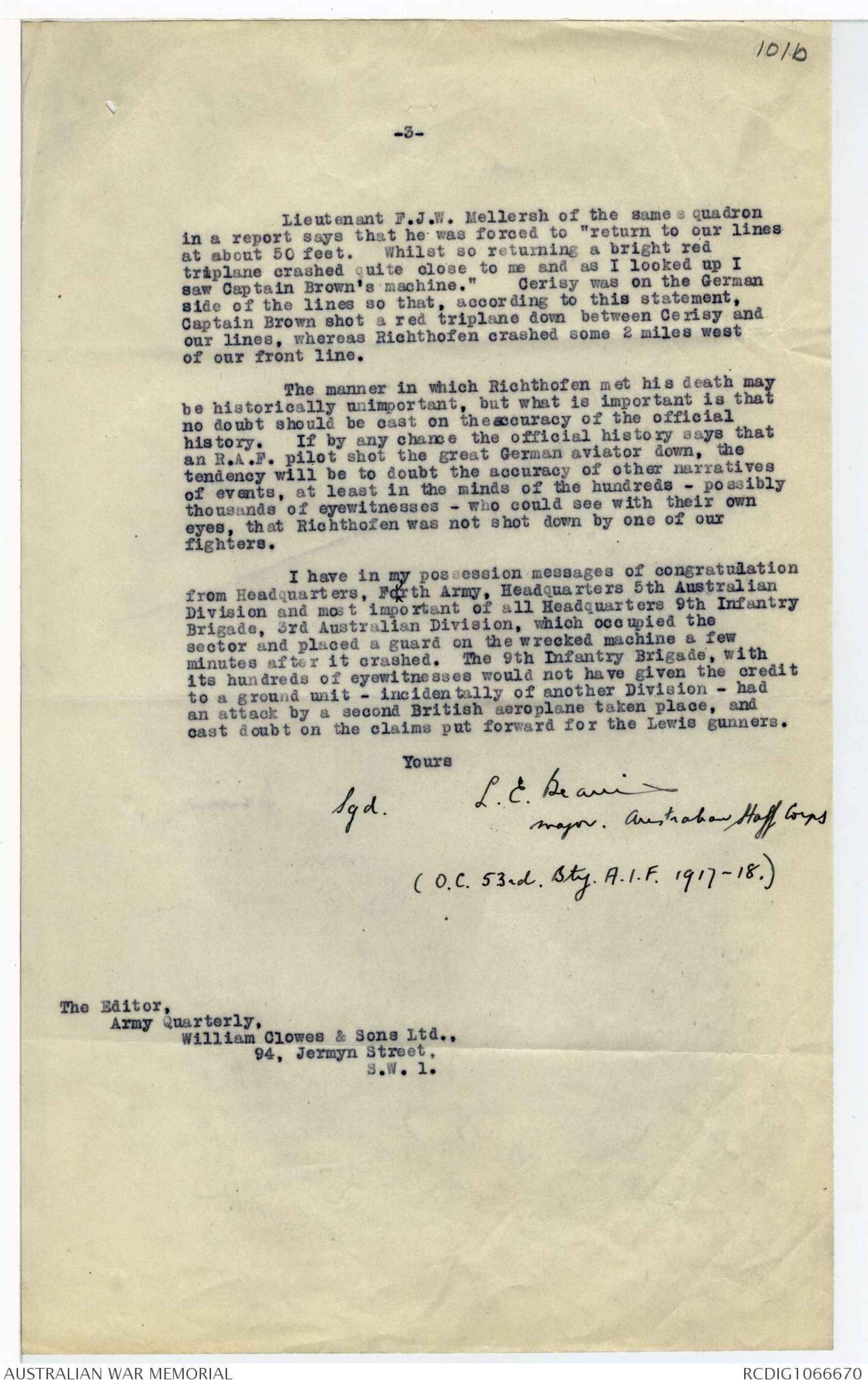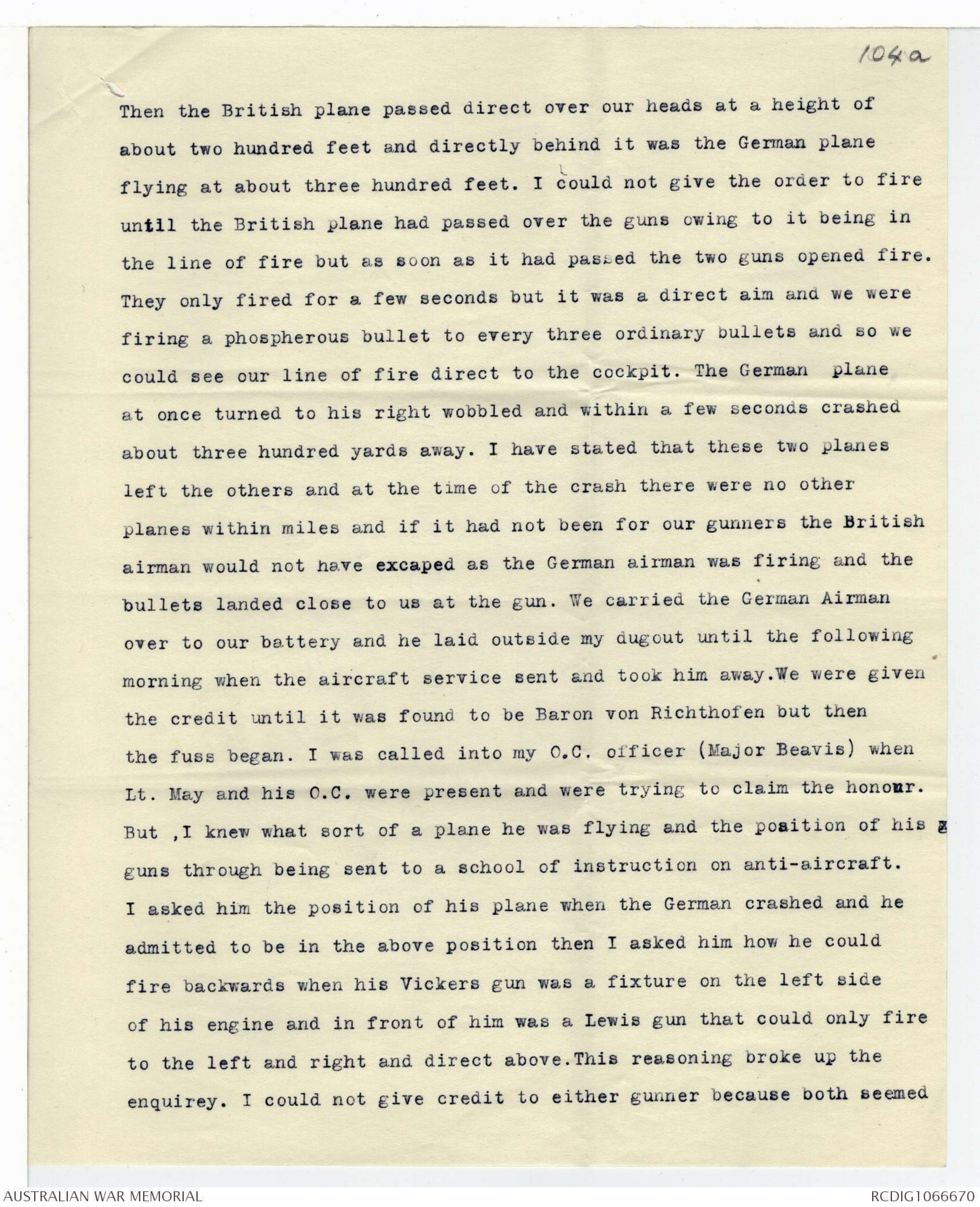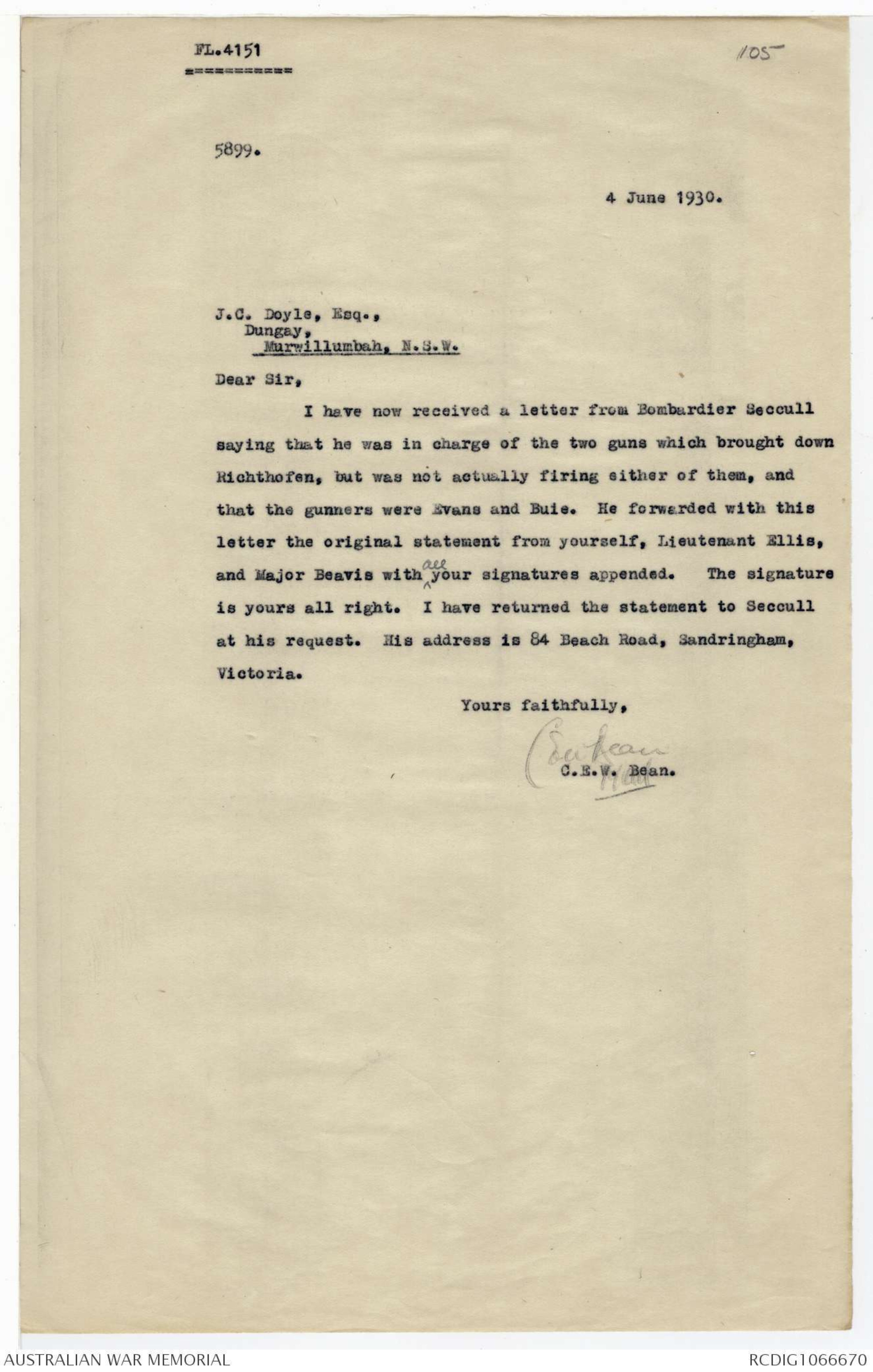Charles E W Bean, Diaries, AWM38 3DRL 606/270 PART 3/1 - 1918 - 1939 - Part 1










AWM38
Official History,
1914-18 War: Records of C E W Bean,
Official! Historian.
Diaries and Notebooks
Item number: 3D606/270 Part 3/1
Tille: Folder, 1918 - 1939
Comprises maps, diagrams, notes, journal
articles and correspondence relating to the
death of Baron von Richthofen.
AVMS8-3DRL6O6/270PART3/1
101
Australia House,
Strand, London, W.C. 2.
5th May, 1931.
Dear Sir,
I have read with interest the article in the
issue of the Army Quarterly on the great German airman
Richthofen. In it, however, it is stated that although
there was some dispute about the manner of his death, it
is now accepted that he was shot down by Captain A.R.
Brovn, a pilot of a British aeroplane. If you will be
good enough to read this letter I hope you will see that
there is ample reason why I should not let this statement
go unchallenged.
As the officer commanding the 35rd Battery,
5th Division, Australian Imperial Force, I am intimately
associated with the claim that one of the two anti-aircraft
Lewis guns of the Batterybwas responsible for the destruction
of Richthofen. I was a close eye witness of the circumstances
and as I had Richthofen's body brought from the
aeroplane to my dugout before it was called for by an
R.A.F. tender, there is no question of the identity of the
airman.
Briefly the circumstances were these. On the
morning of 21st April, 1918, we watched, from the Battery
position, which was a very short distance on the western
slope of tho ridge which runs north between the Ancre and
Somme, the air fight in the vicinity of Sailly-Laurette some
two miles east of the battery, in which fight very large
numbers of British and German aeroplanes were engaged.
Whilst watching, a telephone message came from the Battery
Observation Post, situated near the stone windmill on the
north side of the Somme, about midway between the Battery
and the air fight, that a British aeroplane and a red
aeroplane which was pursuing it, were flying in the general
direction of the Battery. In a very short time the
aeroplane appeared in view flying low along the west-east
valley of the Somme. Keeping on this general course
brought them, owing to the right angle turn of the Somme
to the south, close to the crest of the transverse spur
on which we were stationed. At the time I estimated their
height as 150 feet. The British Sopwith Camel was
deviating to right and left for protection and the red
plane was trying to keep dead on his tail. The Lewis
gunners were standing to their two guns, which were mounted
on posts and fitted with the A.A. ring sights, and as soon
as the Sopwith Camel was clear of the line of fire the guns
opened fire. Immediately the red triplane turned sharply
to the north, became somewhat unsteady in its flight, then
went about N.E., and hit the ground about 400 yards N.N.E.
of where the Lewis guns were. There was no third plane
in the vicinity - certainly not within a radius of at
least 2,000 yards, in fact. there were none to be seen
nearer than the fight still going on over Sailly Lauretté.
101a
-2-
The plane which had been pursued, seeing he was no
longer followed, and no doubt seeing the crash of the
red plane, circled once round on about a 500 yard radius
and then flew west.
As is known,corroborative medical evidence is
to the effect that one bullet entered on the right side
of the chest, was deflected by the spine, and left on
the left side in the vicinity of the heart. With such a
wound Richthofen could not have continued to pursue his
intended victim, so it is plain that the wound was
received just before the crash.
Two junior Air Force medical officers who
examined the body were of opinion that the wound could
only have been sustained from the air. This, which
might be called circumstantial evidence, conflicts with
the direct evidence of eyewitnesses on the ground that
there was no third aeroplane present. Apart from the
direct evidence disproving this theory, it would appear
difficult, if not impossible, to say whether a bullet
came from the ground or the air, considering the
inclination of an aeroplane, especially a small fighting
aeroplane, on the turn, and the fact that a bullet may
be deflected by striking portion of the aeroplane before
hitting the pilot. Colonel G.W. Barber, D.D.M.S.
Australian Corps, examined the body and he has placed on
record that the wound was "just as would be sustained as
result of a bullet from the ground whilst the machine was
banking."
In his official report of the occurrence Captain
A.R. Brown says he "Dived on large formation of 15-20
Albatross Scouts, D.S's and Fokker triplanes, two of which
got on my tail and I came out. Went back again and
dived on pure red triplane which was firing on Lieutenant
I got a long burst into him and he went down
. . . . I got a long burst into him and he went down
vertical. . . . . This report indicates that the
aeroplane attacked was brought down near the main fight,
since Captain Brown says he "went back again and dived
on the enemy machine." Actually, as explained above,
Richthofen crashed some 2 miles west of the main fight
which was in the region of Sailly Laurette. The statement
that he "went down vertical" indicates a spin, or
nose dive or something of that sort. Actually, as stated
above, the plane was only about 150 feet up, and on
ceasing to pursue the Camel, it only lost height gradually
since it struck the ground about 400 yards away. The
conclusion to be drawn from this is that Captain Brown
somewhere near the main "mix-up" fired on some other plane
which was pursuing a British plane and brought it down
"vertical." His official report gives no indication
of the locality where he shot the aeroplane down, beyond
being near Vaux Sur Somme and it would also appear that
he presumes the identity of the enemy pilot. Besides
Richthofen, at least one other red triplane was brought
down in the neighbourhood of Cerisy and no doubt Captain
A.R.Brown brought down this one - or one of them - and has
made a mistake in regard to place and identity of the
enemy pilot.
101b
-3-
Lieutenant F.J.W. Mellersh of the same squadron
in a report says that he was forced to "return to our lines
at about 50 feet. Whilst so returning a bright red
triplane crashed quite close to me and as I looked up I
saw Captain Brown's machine." Cerisy was on the German
side of the lines so that, according to this statement
Captain Brown shot a red triplane down between Cerisy and
our lines, whereas Richthofen crashed some 2 miles west
of our front line.
The manner in which Richthofen met his death may
be historically unimportant, but what is important is that
no doubt should be cast on the accuracy of the official
history. If by any chance the official history says that
an R.A.F. pilot shot the great German aviator down, the
tendency will be to doubt the accuracy of other narratives
of events, at least in the minds of the hundreds - possibly
thousands of eyewitnesses - who could see with their own
eyes, that Richthofen was not shot down by one of our
fighters.
I have in my possession messages of congratulation
from Headquarters, Fo^urth Army, Headquarters 5th Australian
Division and most important of all Headquarters 9th Infantry
Brigade, 3rd Australian Division, which occupied the
sector and placed a guard on the wrecked machine a few
minutes after it crashed. The 9th Infantry Brigade, with
its hundreds of eyewitnesses would not have given the credit
to a ground unit - incidentally of another Division - had
an attack by a second British aeroplane taken place, and
cast doubt on the claims put forward for the Lewis gunners.
Yours
sgd L.E. Beavis
Major. Australian Staff Corps
(O.C. 53rd. Bty. A.I.F. 1917-18.)
The Editor
Army Quarter
William Clowes & Sons Ltd..
94, Jermyn Street,
S.W. 1.
102
6740.
15 June 1931.
Defence Liaison Officer,
Commonwealth of Australia,
Australia House,
Strand,
London, W.C.2.
Dear Sir,
I have to acknowledge, with thanks, the letter from
Major Beavis concerning the death of Baron Richthofen, which you
have sent me. Major Beavis's contentions are amply borne out
by a mass of evidence of Australians.
Yours faithfully,
CEWBean
C.E.W. Bean
Official Historian.
FL.4151
103
5797.
9 May 1930.
J.S. Seccull, Esg.,
84, Beach Road,
Sandringham, Vic.
Dear Sir,
It has become necessary for me to obtain, as far as
possible, definitely accurate details as to the death of
Freiherr von Richthofen. I havo numerous accounts from all
sources, but it is a most difficult matter to disentangle them.
I have for a long time been anxious to consult you on the point,
but did not have your address. I understand that you were a
member of the crew of the 53rd Battery which fired at Richthofen,
and would therefore be a close spectator of the event. Although
it is a long time past, I should be grateful if you could assist
me as to the following matters:-
(1) Who was the gunner on each of the two guns of your
battery who fired the shots, and who afterwards came t
along to Divisional Headquarters, where I think I saw
them?
(2) All accounts speak of two aeroplanes - (a) a fleeing
British "Camel", piloted by Lieutenant May; (b) Richthofen's
triplane, in pursuit of the Camel. Some
accounts say that there was a third aeroplane (British)
close on the tail of Richthofen; others say there was
none within several hundred yards; others say none
within a mile.
Would you kindly give me your recollections on these points?
Yours faithfully,
C.E.W. Bean
Official Historian.
104
84 Beach Road,
Sandringham,
28th May 1930.
[*Seccull sends with this the original
repts of Lt J C Doyle, Lt A.D. Elles,
& May L.C. Beavis, signed by themselves(in Doyle's handwriting).
No59 8 Gnr W J Evans }
No 3801 Gnr R Buie } were firing the 2 guns
Bdr Seccull, J.S., was in charges of the L.Gs. All saw the fight & none
third 'plane.*]
To C.E.W.Bean Esq.,
Dear Sir,
In reply to your letter of the 9th May
I have pleasure in supplying this imforation. The two gunners
that reported to you at General Headquarters were gunners
Evans & Buie. I should have gone on that occasion, but being
the only N.C.O. in charge of the Lewis guns, it was not possible
to do so. There has been much argument about this affair but
undoubtedly the gun crew of the 53rd Battery brought him down.
I was on parade the day Gen. Birdwood congratulated us, and we
also received congratulations from the officers at H.Q. and other
O.C.s who had a full view of the event. The following is a detail
of the event :- My gun crew consisted of four men and on the
morning of the event I was at the Lewis guns and at a distance
of about four to ^MILES six away and at a great height a battle was
going on between a number of British and German planes.After
they had been in battle for about thirty minutes a British plane
left the others chased by a German plane painted red.After
many turns and dives the German plane got above and behind
the British plane and started to force it down toward our guns.
I called for the gunners then Buie took up No 1 gun and Evans
took N o 2. The guns were about five feet apart. After the planes
had travelled about two miles they were still in the same position
104a
Then the British plane passed direct over our heads at a height of
about two hundred feet and directly behind it was the German plane
flying at about three hundred feet. I could not give the order to fire
until the British plane had passed over the guns owing to it being in
the line of fire but as soon as it had passed the two guns opened fire.
They only fired for a few seconds but it was a direct aim and we were
firing a phospherous bullet to every three ordinary bullets and so we
could see our line of fire direct to the cockpit. The German plane
at once turned to his right wobbled and within a few seconds crashed
about three hundred yards away. I have stated that these two planes
left the others and at the time of the crash there were no other
planes within miles and if it had not been for our gunners the British
airman would not have escaped as the German airman was firing and the
bullets landed close to us at the gun. We carried the German Airman
over to our battery and he laid outside my dugout until the following
morning when the aircraft service sent and took him away. We were given
the credit until it was found to be Baron von Richthofen but then
the fuss began. I was called into my O.C. officer (Major Beavis) when
Lt. May and his O.C. were present and were trying to claim the honour.
But ,I knew what sort of a plane he was flying and the position of his X
guns through being sent to a school of instruction on anti-aircraft.
I asked him the position of his plane when the German crashed and he
admitted to be in the above position then I asked him how he could
fire backwards when his Vickers gun was a fixture on the left side
of his engine and in front of him was a Lewis gun that could only fire
to the left and right and direct above. This reasoning broke up the
enquirey. I could not give credit to either gunner because both seemed
104b
to be direct shots and it was over so sudden.
I am enclosing herewith the official statement
made by three officers of the 53rd Battery. This statement was sent to
Headquarters for a general report and was used at the enquirey which
followed. Trusting this imformation will be of use to you,
I remain,
Yours faithfully,
Joseph Seccull
P.S. I would be glad if you would see that the offical reports are
returned to me as soon as possible. JS
[*returned
4/6/30
CWEB*]
FL.4151
105
5899.
4 June 1930.
J.C. Doyle. Esq..
Dungay,
Murwillumbah, N.S.W.
Dear Sir,
I have now received a letter from Bombardier Seccull
saying that he was in charge of the two guns which brought down
Richthofen, but was not actually firing either of them, and
that the gunners were Evans and Buie. He forwarded with this
letter the original statement from yourself, Lieutenant Ellis,
and Major Beavis with, your ^all signatures appended. The signature
is yours all right. I have returned the statement to Seccull
at his request. His address is 84 Beach Road, Sandringham,
Victoria.
Yours faithfully,
CEW Bean
CEWB
C.E.W. Bean.
 Sandy Mudie
Sandy MudieThis transcription item is now locked to you for editing. To release the lock either Save your changes or Cancel.
This lock will be automatically released after 60 minutes of inactivity.